Abstract
In recent years, an increase in the frequency of low-sunlight conditions due to climate change has resulted in a decline in the yield and quality of crops for greenhouse farmers, leading to significant challenges in maintaining optimal plant growth. The crop growth model can be used to predict changes in cucumber yield in response to variations in sunlight, which can help efficiently address sunlight shortages. The objective of this study was to improve and validate the model for predicting cucumber yield under different light environment conditions, including shading and supplemental lighting. The model comprises three steps: LAI prediction, daily assimilate yield prediction, and fruit yield prediction, each of which involves modifying the coefficients applied to suit the cucumber cultivar and environment condition. The improved model demonstrated a high degree of accuracy in predicting cucumber yields in the control and low-sunlight treatments (10, 20, and 30% shading), with a coefficient of determination (R2) > 0.98. When supplemental lighting was incorporated into the control and shading treatments, the accuracy of the improved model in predicting cucumber yield was also high, with a coefficient of determination (R2) > 0.99. The model also accurately predicted the decrease in cucumber fruit yield under low-sunlight conditions (shading treatments) and the increase in yield due to supplemental lighting. The findings of this study indicate that the improved cucumber yield prediction model can be applied to assess the efficacy of yield reduction in low-sunlight conditions and the potential for yield enhancement through supplemental lighting.
1. Introduction
In Korea, cucumber is one of the major fruit vegetable crops, and farmers who cultivate cucumbers in controlled-environment facilities have high incomes []. As a vining crop, cucumber produces fruit per unit from female flowers at each node, allowing for continuous fruit yields throughout the growing season. Therefore, farmers produced cucumbers year-round in plastic greenhouses with a wide variety of cultivars in different cropping types for different regions []. Cucumbers are relatively tolerant of high temperatures; however, growth is delayed, and malformations increase under low temperature and low light conditions [].
As global warming and environmental pollution intensify, a range of extreme weather events has been observed, resulting in a variety of damages in recent years []. In particular, the lack of sunlight due to prolonged rainy seasons, increased rainfall and snowfall [,], and frequent occurrence of particular matters [] caused by extreme weather events are increasing the difficulty of crop cultivation. A variety of environmental factors, such as light, temperature, CO2 concentration, and humidity, affect plant growth and development. Of these, light is a particularly crucial environmental factor for plant growth []. Low light conditions can restrict the assimilation of plant carbon and inhibit the activity of carbon assimilation enzymes [], consequently leading to a reduction in yield and various physiological disorders []. The most direct solution to the lack of sunlight is to maintain or improve crop yields through supplemental lighting in a greenhouse. A number of studies have demonstrated that supplemental lighting has the potential to improve the yield and quality of fruit vegetables [,], including cucumbers []. However, the widespread adoption of supplemental lighting among farmers has been limited primarily by the considerable initial installation costs and subsequent electricity bills [].
Crop models play a crucial role in understanding and predicting crop growth and development by simulating the effects of genetic variations, management practices, and environmental conditions []. These models can dynamically simulate key crop characteristics, including the timing of emergence and flowering, biomass accumulation, and yield [,]. In general, these models are classified into empirical and mechanistic (also known as process-based) crop models; (1) empirical models consist of statistical or mathematical equations that describe the relationships between various variables, such as light and crop yield [], and (2) the mechanistic model can clarify the interrelationships among various factors that are involved in crop growth and development processes []. Since crop models simulate the phenomena that occur in real crops, they can significantly help farmers in decision making. By allowing farmers to assess the impact of environmental changes, such as temperature, light, and CO2 concentration, on crop production without the necessity of undergoing the actual cultivation process, these models provide a valuable tool for optimizing agricultural practices []. In horticultural crop models, the main processes consist of the simulation of leaf area, light interception, dry matter production, and partitioning []. For cucumber, several crop models have been developed and studied to enhance understanding and optimize production [,].
The objective of this study was to ascertain whether a crop model can be utilized to predict changes in cucumber growth in response to shading treatments when subjected to low-sunlight conditions, which has become a significant issue in recent years. Additionally, the study aimed to evaluate the applicability and reliability of crop models for predicting the effects of supplemental lighting on cucumber crops under low-sunlight conditions.
2. Materials and Methods
2.1. Plant Material and Cultivation Conditions
We conducted two cultivation experiments to improve and validate the crop model. The experiments were conducted in plastic greenhouses at the Protected Horticulture Research Institute, National Institute of Horticultural and Herbal Science (128.42° E, 35.23° N). The cultivar of cucumber used in this study was ‘Sindong’ (Haeoreum Seed Co., Asan, Republic of Korea). In the first experiment for model calibration, the cucumber seedlings with three leaves were transplanted on 20 February 2023 and cultivated until 17 April 2023. During the experimental period, leaf area, shoot dry weight, and fruit fresh and dry weights were measured periodically, and environmental data (air temperature, light intensity, relative humidity, and CO2 concentration) in a greenhouse were collected using the data logger and sensors (aM-21AL, WISE Sensing Inc., Yongin, Republic of Korea). Figure 1 shows the changes in environmental conditions, including air temperature, relative humidity, light intensity, and CO2 concentration during the experimental period. The crops were drip-irrigated using the nutrient solution (Daeyu Mulpure No. 2, Daeyu Co., Ltd., Seoul, Republic of Korea) of EC 1.5 dS·m−1 and pH 6.5. The second experiment for model validation was conducted from 20 February to 28 April 2023 in greenhouses that were distinct from the one utilized for the first experiment. The seedlings of the ‘Sindong’ cucumber with three leaves were transplanted and drip-irrigated using the nutrient solution that had been established for the first experiment. For establishing low-sunlight conditions, dust was attached to the covering material (polyethylene film) to build treatments with 10, 20, and 30% reduced light transmittance. Additionally, white LED lamps for plant growing (R:G:B = 5:3:2, Bissol LED, Seoul, Republic of Korea) were installed in each of the shading treatments and irradiated for four hours after sunrise with PPFD 150 μmol·m−2·s−1. In the second experiment, the environmental conditions were controlled using the side windows, ventilation fans, and heating system in order to maintain the optimal temperature range for cucumber cultivation, as conducted in the first experiment. During the cultivation period in the second experiment, cucumber fruits were harvested periodically in the eight total treatments; control (CK), 10, 20, and 30% reduced light transmittance treatments (SH10, 20, and 30%), and supplemental lighting treatments in CK, SH10, SH20, and SH30 (SL, SL + SH10, SL + SH20, SL + SH30).

Figure 1.
Environmental conditions in the greenhouse ((A) air temperature and relative humidity, (B) daily cumulated PAR and CO2 concentration) during the period of cucumber cultivation in the first experiment.
2.2. Crop Model Calibration and Validation
We used the empirical growth model developed by Maeda and Ahn [] for Japanese cucumber. The first experiment enabled the determination of several key parameters, including light use efficiency, dry mass distribution in fruit, and fruit dry matter content.
In this model, leaf area was calculated using leaf length and leaf width [] as follows:
where LA is the leaf area (m2/plant), LI is the leaf length, and LW is the leaf width. The a value was calculated as a function of DAT (days after transplanting) from the LI, LW, and LA measured in the first experiment.
Leaf area index (LAI) was calculated by multiplying leaf area by planting density as follows:
where LAI is the leaf area index (m2·m−2), LA is the leaf area, and PD is the planting density. In this study, the planting density was 2.69 plants·m−2.
Daily intercepted light from the plants were calculated using the following equation:
where IL is the daily intercepted light, k is the light extinction coefficient, LAI is the leaf area index, and PAR is the photosynthetically active radiation. In this study, the k value of 0.9 was used from previous research by Maeda and Ahn []. The indoor PAR was obtained from a PPFD sensor installed in the greenhouse, and the daily LAI values were determined by means of a linear interpolation of the estimated LAI based on the periodical measurements in the first experiment.
To calculate the daily assimilate production from the light received by the plant, we need to know the light use efficiency (LUE) of the plant canopy. In order to obtain LUE, the destructive measurements of dry matter in cucumber crops were conducted at 7, 14, 21, 28, 42, and 56 DAT in the first experiment. The LUE value was calculated by performing a linear regression analysis on the relationship between cumulative IL and dry matter production (Figure 2).
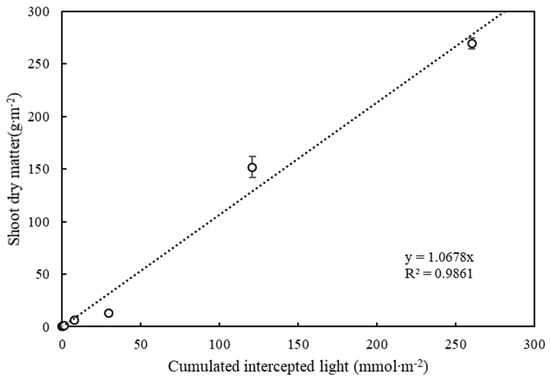
Figure 2.
Total dry matter of cucumber as a function of cumulated intercepted light in the first experiment.
By multiplying the LUE and IL derived from the daily LAI value, the dry matter of the top (DM, g·m−2) was calculated, and total dry matter (TDM, g·m−2) was calculated by integrating the daily DM value as follows:
Dry and fresh fruit yields were calculated using dry matter distribution and dry matter content as follows:
where DFY is the dry fruit yield (g·m−2), DM is the dry matter of top (g·m−2), DMD is the dry matter distribution for fruit, FY is the fresh fruit yield (g·m−2), and DMC is the dry matter content of fruit. The DMD was obtained by dividing the DFY by the TDM measured at 42 and 56 DAT, and the DMC was calculated from the dry and fresh fruit weights of 10 fruit samples at 42, 48, and 56 DAT.
In the first experiment, the requisite coefficients and values were obtained to facilitate improvements to the model. To validate the model, the same cucumber cultivar was cultivated under different light conditions in the second experiment, and the actual yields were recorded based on the fruits harvested 49, 56, and 63 days after transplanting (DAT).
2.3. Model Evaluation
To evaluate the predictive performance of the model following calibration and validation, we calculated the coefficient of determination (R2) and the root mean square error (RMSE).
where is the number of the values, is the observed value, is the predicted value, and is the average of the total values.
3. Results
The model developed to predict Japanese cucumber yield was calibrated in this study, and the results demonstrated that the calibrated model exhibited reasonable predictive efficacy with respect to LAI and TDM (Figure 3).
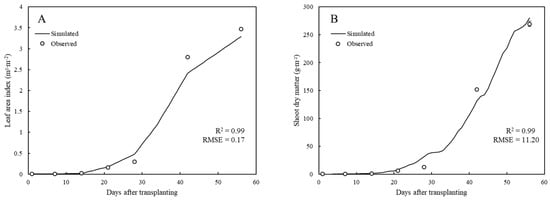
Figure 3.
Simulation of cucumber crop growth ((A) leaf area index, (B) shoot dry weight) using the calibrated model in the first experiment.
The calibrated model demonstrated an acceptable level of accuracy in predicting cucumber yield changes in response to light environment alterations in the second experiment. The calibrated model demonstrated a high degree of accuracy in predicting cucumber fruit yield in the control, with a coefficient of determination of 0.98. Furthermore, it effectively captured the variability in cucumber fruit yield observed under low-sunlight conditions with the 10, 20, and 30% shading treatments (Figure 4). At 63 DAT, the cucumber yield was found to be over-predicted in the control and all shading treatments.
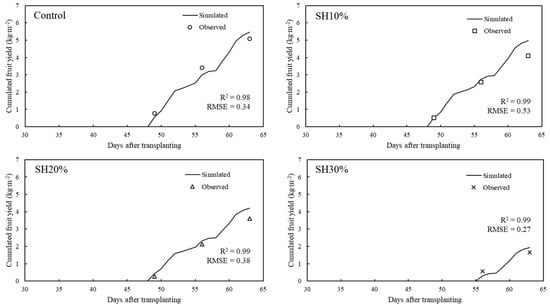
Figure 4.
Simulation of cumulated cucumber fruit yield in the control (no shading) and the 10, 20, and 30% shading treatments using the calibrated model.
The calibrated model also demonstrated an accurate prediction of cucumber yields in the supplemental lighting treatments (Figure 5). The over-prediction of cucumber yield at 63 DAT was observed in all supplemental lighting treatments. In all the supplemental lighting treatments, the calibrated model showed a high coefficient of determination of 0.99 in the simulation of the change in cucumber yield.
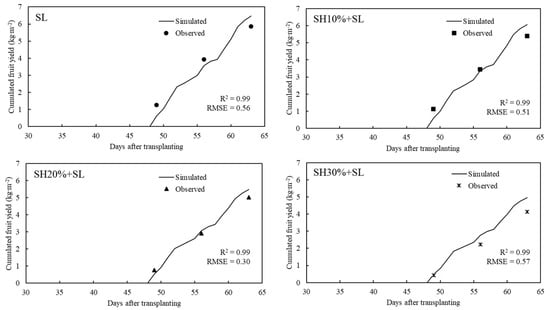
Figure 5.
Simulation of cumulated cucumber fruit yield in the control with supplemental lighting and the 10, 20, and 30% shading treatments with supplemental lighting using the calibrated model.
In all the treatments including shading and supplemental lighting, a regression analysis of the predicted and observed fruit yields showed that the calibrated model exhibited a high degree of predictive accuracy, with a coefficient of determination of 0.97 (Figure 6).
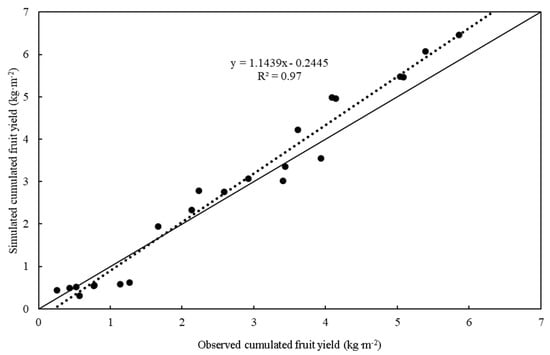
Figure 6.
Correlation between the simulated and observed cucumber yields in the control, shading, and supplemental lighting treatments in the second experiment.
The total fruit yield exhibited a quadratic trend, initially increasing with the integrated light, and then decreasing beyond a certain threshold (Figure 7). The total fruit yield as a function of cumulative light was generally overestimated by the calibrated model in comparison to the measurements.
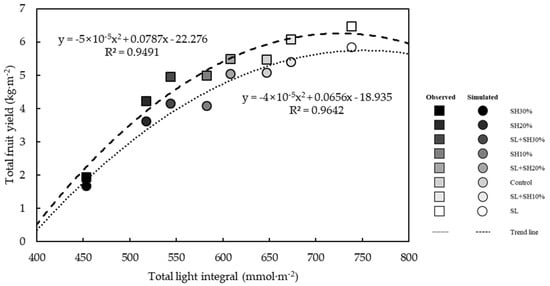
Figure 7.
Changes in the observed and simulated total fruit yield under different integrated light conditions.
The predicted reduction in cucumber fruit yield resulting from shading treatments was found to be less pronounced than the observed reduction, particularly in the shading 10% treatment; the predicted reduction in yield was 8.85%, which was lower than half of the observed reduction of 19.56% (Table 1).

Table 1.
Observed and simulated reductions of cucumber fruit yields in the shading treatments as compared to the control.
The effect of supplemental lighting on cucumber fruit yield was found to increase in both observation and simulation in the higher shading treatments (Table 2). The predicted increase in cucumber fruit yield by supplemental lighting was found to be lower than the observed increase, with the discrepancy being approximately 10% in the shading 10 and 20% treatments with supplemental lighting.

Table 2.
Observed and simulated increases of cucumber fruit yields in the control and shading treatments by supplementary lighting.
4. Discussion
Cucumber is one of the important fruit vegetables along with tomato and pepper, and extensive research has been conducted on yield prediction models [,,]. Dry matter production is a key factor in determining cucumber yield, and it is driven by two main factors: the amount of light intercepted by the plants and the LUE. The amount of light intercepted by plants is dependent on PAR, LAI, and light extinction coefficients in the plant canopy [,]. Maeda and Ahn [] developed the equations for estimating the dry matter and fruit yield for Japanese cucumber, and this model showed an excellent capacity to predict the cucumber fruit yield. In this study, we selected this model for its emphasis on light-related factors and its efficacy in predicting changes in dry matter and fruit yield using simple equations. We calibrated the model by calculating the ‘a’ coefficient for leaf area prediction and the value of LUE for Korean cucumber cultivar, and by determining the ‘k’ coefficient for the intercepted light in the plant canopy according to the previous study []. In the previous study, the model calculated the PAR in the greenhouse using external solar radiation data to reflect the proportion of light transmitted into the greenhouse (50%). In this study, we used the data from PPFD sensors in the greenhouses to calculate the precise change in light intensity due to shading and supplemental lighting.
The empirical model is constructed on the statistical relationships between environmental factors and yield, with a limited number of parameters that can be readily derived. The level of complexity inherent in the mechanistic model is typically higher than that of empirical models, and this can require a significant amount of data input, which ultimately makes them less suitable for yield prediction purposes []. The empirical model is characterized by its simplicity and practicality. However, it is essential to calibrate and validate the model to enhance its applicability. Maeda and Ahn [] calibrated and validated the crop model originally applied to tomato by Saito et al. [] for Japanese cucumber. In order to apply this model to cucumber cultivation in Korea, we calibrated the model using the environment data in the greenhouse and the growth data destructively measured 7 times during the cultivation period, and confirmed that the calibrated model accurately predicted LAI and dry matter, which are important components of cucumber fruit yield prediction. In addition, the model was validated in the second experiment for the prediction of cucumber fruit yield under various light conditions. The model demonstrated an excellent capacity to predict the changes in cucumber fruit yield in the shading and supplementary lighting treatments. The model resulted in an over-prediction of cucumber fruit yield at 63 DAT for all treatments, including shading and supplementary lighting. Maeda and Ahn [] reported that the discrepancy between observed and predicted results was greater during the later stages of growth, and they considered the possibility of a reduction in dry matter production capacity, which could be contingent on the progression of the growth stage. However, in our study, the calibrated model demonstrated accurate predictions of shoot dry weight throughout the cultivation period in the first experiment. Accordingly, the discrepancy can be attributed to the model’s inability to reflect fluctuations in DMD and DMC throughout the harvesting period. Marcelis [] reported that the fruit growth and biomass allocation to fruit were affected by irradiance. It was postulated that the discrepancy between the model predictions and the measurements can be attributed to the inability of the model to account for DMD variation under different light conditions and DMC variation by harvest time.
In order to assess the predictability of cucumber fruit yield reduction in low-sunlight conditions using the model, we determined the observed and simulated reduction in cucumber fruit yield in the 10, 20, and 30% shading treatments set to low-sunlight conditions in comparison to the control (no shading). Despite the prediction of a lower reduction in cucumber fruit yield in the 10% shading treatment, a linear regression analysis of the observed and simulated reduction values of cucumber fruit yield by shading treatments revealed a high level of accuracy, with a coefficient of determination of 0.99. We confirmed that the model can be utilized to simulate the impact of low-sunlight conditions on cucumber yields, which have been exacerbated by recent climate change in Korea. Many researchers have applied crop models to simulate the impact of climate change on crop yield in agricultural fields [,,]. The open field is subject to a multitude of environmental factors that are responsive to change as a consequence of climate change. When these factors are incorporated into a model, the complexity of environmental variables can result in an increased level of uncertainty in predicting crop growth and yield. In protected horticulture, low-sunlight conditions, such as fine dust and prolonged rainfall, have a notable impact on the light transmitted into the greenhouse. However, these conditions have a negligible effect on other environmental factors, including air temperature and soil moisture. Accordingly, our findings suggested that the calibration of an empirical crop model, which calculates dry matter production and partitioning based on the intercepted light by crop canopy, LUE, and LAI of cucumber grown in the greenhouse, has enabled the successful prediction of yield reduction under low-sunlight conditions.
The predicted increases of cucumber fruit yield by supplemental lighting were found to be highly accurate, with a coefficient of determination of 0.99 in a regression analysis with the observed increases. Our results also demonstrated that the model can be utilized to ascertain the beneficial impact of supplementary lighting, which is becoming increasingly crucial in addressing the low-sunlight issue, on crop yields for the purpose of economic assessment. Many researchers reported the positive effect of supplemental lighting on cucumber growth and yield in greenhouses [,,]. However, the implementation of supplemental lighting entails a considerable investment in equipment, including lamps, as well as associated maintenance costs (electricity). It is essential to accurately assess the increase in yield resulting from supplemental lighting and to conduct a strategic management analysis to ensure that farmer income is optimized []. The model is capable of accurately predicting crop yield changes due to supplemental lighting using a few easily accessible environmental and crop growth parameters. This makes it an invaluable tool for farmers to utilize in making optimal decisions concerning the installation and application of supplemental lighting.
5. Conclusions
In this study, the empirical crop model that was improved for use with Japanese cucumbers was calibrated by determining the coefficients and LUE in relation to the environmental and growth data of Korean cucumbers in the greenhouse. The calibrated model for Korean cucumber was also validated using the experimental data obtained from the shading and supplemental lighting treatments. The results demonstrated that the model is capable of accurately predicting cucumber fruit yields under various light conditions. Furthermore, the reductions in fruit yield under low-sunlight conditions (shading treatments) and the increases in fruit yield due to supplemental lighting under low-sunlight conditions were accurately simulated. It is our contention that the model can serve as a reliable tool for decision-making support, particularly for farmers and crop insurance companies, if further model improvements are made to reflect a more comprehensive range of Korean cucumber cultivars and environmental conditions.
Author Contributions
Conceptualization, I.H. and Y.K.; data curation, I.H.; formal analysis, I.H.; funding acquisition, Y.K. and S.J.H.; investigation, I.H. and J.Y.; methodology, Y.K.; project administration, Y.K. and S.J.H.; resources, Y.K. and S.J.H.; software, I.H.; supervision, Y.K. and S.J.H.; validation, Y.K.; visualization, I.H.; writing—original draft preparation, I.H.; writing—review and editing, Y.K. All authors have read and agreed to the published version of the manuscript.
Funding
This work was carried out with the support of the “Cooperative Research Program for Agriculture Science and Technology Development (Project No. PJ01707202)” Rural Development Administration, Republic of Korea.
Data Availability Statement
The original contributions presented in the study are included in the article, further inquiries can be directed to the corresponding author.
Conflicts of Interest
The authors declare no conflicts of interest.
References
- RDA (Rural Development Administration). 2022 Agricultural Income Data Collection; RDA: Jeonju, Republic of Korea, 2023; pp. 20–47. ISSN 2983-3809. (In Korean) [Google Scholar]
- Lee, S.K.; Wee, T.S.; Choi, C.G.; Lee, H.J.; Koh, K.D.; Uhm, Y.C.; Jang, Y.A.; Sung, K.C.; Choi, K.S.; Kim, H.H.; et al. Cucumber-Agricultural Technology Guide 107; RDA (Rural Development Administration): Jeonju, Republic of Korea, 2021; pp. 43–52. ISBN 9788948071368. (In Korean) [Google Scholar]
- Shim, G.S.; Choi, D.B.; Lee, H.R.; Kim, S.C.; Lee, J.S.; Jung, K.H.; Han, K.H.; Hwang, J.H.; Kwon, J.K.; Lee, D.S.; et al. Smart Greenhouse Environmental Management Guidelines: 2017; RDA (Rural Development Administration): Jeonju, Republic of Korea, 2017; pp. 194–200. ISBN 9788948040821. (In Korean) [Google Scholar]
- Lee, H.M.; Jung, H.C.; Wie, J.E.; Moon, B.G. Climate over the Korean Peninsula: Heat Wave, Cold Wave, Drought, and Ocean Warming. J. Sci. Sci. Educ. 2018, 43, 13–22. (In Korean) [Google Scholar]
- Woo, S.H.; Yim, S.Y.; Kwon, M.H.; Kim, D.J. Decadal Change in Rainfall During the Changma Period in Early-2000s. Atmosphere 2017, 27, 345–358. (In Korean) [Google Scholar] [CrossRef]
- Yoon, S.; Kim, J.H.; Hwang, I.; Kim, D.; Shin, J.; Son, J.E. Effect of Stem Number on Growth, Fruit Quality, and Yield of Sweet Peppers Grown in Greenhouses under Supplemental Lighting with High Pressure Sodium Lamps in Winter. J. Bio-Environ. Control 2021, 30, 237–243. (In Korean) [Google Scholar] [CrossRef]
- Hong, I.; Ha, Y.; Kwack, Y. Changes in Light Transmittance of Greenhouse Covering Materials and Cucumber Growth as Affected by Particulate Matter. J. Bio-Environ. Control 2023, 32, 312–318. [Google Scholar] [CrossRef]
- Zhou, J.; Li, P.P.; Wang, J.Z.; Fu, W. Growth, Photosynthesis, and Nutrient Uptake at Different Light Intensities and Temperatures in Lettuce. HortScience 2019, 54, 1925–1933. [Google Scholar] [CrossRef]
- Dai, Y.; Shen, Z.; Liu, Y.; Wang, L.; Hannaway, D.; Lu, H. Effects of shade treatments on the photosynthetic capacity, chlorophyll fluorescence, and chlorophyll content of Tetrastigma hemsleyanum Diels et Gilg. Environ. Exp. Bot. 2009, 65, 177–182. [Google Scholar] [CrossRef]
- Dong, C.; Fu, Y.; Liu, G.; Liu, H. Low light intensity effects on the growth, photosynthetic characteristics, antioxidant capacity, yield and quality of wheat (Triticum aestivum L.) at different growth stages in BLSS. Adv. Space Res. 2014, 53, 1557–1566. [Google Scholar] [CrossRef]
- Paucek, I.; Pennisi, G.; Pistillo, A.; Appolloni, E.; Crepaldi, A.; Calegari, B.; Spinelli, F.; Cellini, A.; Gabarrell, X.; Orsini, F.; et al. Supplementary LED Interlighting Improves Yield and Precocity of Greenhouse Tomatoes in the Mediterranean. Agronomy 2020, 10, 1002. [Google Scholar] [CrossRef]
- Yu, J.; Yun, J.H.; Hwang, S.Y.; Park, E.W.; Hwang, J.H.; Choi, H.E.; Koo, J.K.; Hwang, H.S.; Hwang, S.J. Effect of Shading and Supplemental Lighting for Greenhouse Cultivation of Cucumber in Summer Season. J. Bio-Environ. Control 2023, 32, 226–233. (In Korean) [Google Scholar] [CrossRef]
- Kowalczyk, K.; Olewnicki, D.; Mirgos, M.; Gajc-Wolska, J. Comparison of Selected Costs in Greenhouse Cucumber Production with LED and HPS Supplemental Assimilation Lighting. Agronomy 2020, 10, 1342. [Google Scholar] [CrossRef]
- Chapagain, R.; Remenyi, T.R.; Harris, R.M.B.; Mohammed, C.L.; Huth, N.; Wallach, D.; Rezaei, E.E.; Ojeda, J. Decomposing crop model uncertainty: A systematic review. Field Crops Res. 2022, 279, 108448. [Google Scholar] [CrossRef]
- Sinclair, T.R.; Seligman, N. Criteria for publishing papers on crop modeling. Field Crops Res. 2000, 68, 165–172. [Google Scholar] [CrossRef]
- Lim, J.T.; Lee, B.W.; Shin, J.C.; Lee, C.K.; Moon, K.H.; Lee, K.O. Theory and Practice of Crop Growth Modeling = Crop Growth Modeling; Kyungjinmunhwa: Seoul, Repubic of Korea, 2009; pp. 23–50. ISBN 9788959960606. (In Korean) [Google Scholar]
- Hammer, G.L.; Kropff, M.J.; Sinclair, T.R.; Porter, J.R. Future contributions of crop modelling—From heuristics and supporting decision making to understanding genetic regulation and aiding crop improvement. Eur. J. Agron. 2002, 18, 15–31. [Google Scholar] [CrossRef]
- Rauff, K.O.; Bello, R. A Review of Crop Growth Simulation Models as Tools for Agricultural Meteorology. Agric. Sci. 2015, 6, 1098–1105. [Google Scholar] [CrossRef]
- Kim, S.K.; Lee, S.K.; Lee, H.J.; Lee, J.K. Horticultural Crop Growth Models for Smart Farms: Utilizing Technical, Descriptive, and Structural Growth Models. J. Korean Soc. Agric. Eng. 2017, 59, 28–37. (In Korean) [Google Scholar]
- Mareclis, L.F.M.; Heuvelink, E.; Goudriaan, J. Modelling biomass production and yield of horticultural crops: A review. Sci. Hortic. 1998, 74, 83–111. [Google Scholar] [CrossRef]
- Mareclis, L.F.M. Fruit growth and biomass allocation to the fruits in cucumber. 2. Effect of irradiance. Sci. Hortic. 1993, 54, 123–130. [Google Scholar] [CrossRef]
- Maeda, K.; Ahn, D.H. Estimation of Dry Matter Production and Yield Prediction in Greenhouse Cucumber without Destructive Measurements. Agriculture 2021, 11, 1186. [Google Scholar] [CrossRef]
- Cho, Y.Y.; Oh, S.; Oh, M.M.; Son, J.E. Estimation of individual leaf area, fresh weight, and dry weight of hydroponically grown cucumbers (Cucumis sativus L.) using leaf length, width, and SPAD value. Sci. Hortic. 2007, 111, 330–334. [Google Scholar] [CrossRef]
- Maeda, K.; Ahn, D.H. Analysis of Growth and Yield of Three Types Cucumbers (Cucumis sativus L.) Based on Yield Components. Horticulturae 2022, 8, 33. [Google Scholar] [CrossRef]
- Marcelis, L.F.M. A Simulation Model for Dry Matter Partioning in Cucumber. Ann. Bot. 1994, 74, 43–52. [Google Scholar] [CrossRef] [PubMed]
- Marcelis, L.F.M.; Gijzen, H. Evaluation under commercial conditions of a model of prediction of the yield and quality of cucumber fruits. Sci. Hortic. 1998, 76, 171–181. [Google Scholar] [CrossRef]
- Ding, X.; Jiang, Y.; Hui, D.; He, L.; Huang, D.; Yu, J.; Zhou, Q. Model Simulation of Cucumber Yield and Microclimate Analysis in a Semi-closed Greenhouse in China. HortScience 2019, 54, 547–554. [Google Scholar] [CrossRef]
- Higashide, T.; Heuvelink, E. Physiological and Morphological Changes Over the Past 50 Years in Yield Components in Tomato. J. Am. Soc. Hortic. Sci. 2009, 134, 460–465. [Google Scholar] [CrossRef]
- Higashide, T.; Gotoh, I.; Suzuki, K.; Yasuba, K.; Tsukazawa, K.; Ahn, D.H.; Iwasaki, Y. Effects of Pinching and Lowering on Cucumber Yield and Yield Components. Hortic. Res. 2012, 11, 523–529. [Google Scholar] [CrossRef]
- Paola, A.D.; Valentini, R.; Santini, M. An overview of available crop growth and yield models for studies and assessments in agriculture. J. Sci. Food Agric. 2016, 96, 709–714. [Google Scholar] [CrossRef]
- Saito, T.; Kawasaki, Y.; Ahn, D.H.; Ohyama, A.; Higashide, T. Prediction and Improvement of Yield and Dry Matter Production Based on Modeling and Non-destructive Measurement in Year-round Greenhouse Tomatoes. Hortic. J. 2020, 89, 425–431. [Google Scholar] [CrossRef]
- Mulla, S.; Singh, S.K.; Singh, K.K.; Praveen, B. Climate Change and Agriculture: A Review of Crop Models. In Global Climate Change and Environmental Policy; Venkatramanan, V., Shah, S., Prasad, R., Eds.; Springer: Singapore, 2020; pp. 423–435. ISBN 9789811395703. [Google Scholar]
- Feng, X.; Tian, H.; Cong, J.; Zhao, C. A method review of the climate change impact on crop yield. Front. For. Glob. Chang. 2023, 6, 1198186. [Google Scholar] [CrossRef]
- Hu, T.; Zhang, X.; Khanal, S.; Wilson, R.; Leng, G.; Toman, E.M.; Wang, X.; Li, Y.; Zhao, K. Climate change impacts on crop yields: A review of empirical findings, statistical crop models, and machine learning methods. Environ. Model. Softw. 2024, 179, 106119. [Google Scholar] [CrossRef]
- Kowalczyk, K.; Gajc-Wolska, J.; Mirgos, M.; Geszprych, A.; Kowalczyk, W.; Sieczko, L.; Niedzińska, M.; Gajewski, M. Mineral nutrients needs of cucumber and its yield in protected winter cultivation, with HPS and LED supplementary lighting. Sci. Hortic. 2020, 265, 109217. [Google Scholar] [CrossRef]
- Gajc-Wolska, J.; Kowalczyk, K.; Przybysz, A.; Mirgos, M.; Orliński, P. Photosynthetic Efficiency and Yield of Cucumber (Cucumis sativus L.) Grown under HPS and LED Lighting in Autumn–Winter Cultivation. Plants 2021, 10, 2042. [Google Scholar] [CrossRef] [PubMed]
- Kwon, Y.B.; Lee, J.H.; Roh, Y.H.; Choi, I.L.; Kim, Y.; Kim, J.; Kang, H.M. Effect of Supplemental Inter-Lighting on Paprika Cultivated in an Unheated Greenhouse in Summer Using Various Light-Emitting Diodes. Plants 2023, 12, 1684. [Google Scholar] [CrossRef] [PubMed]
Disclaimer/Publisher’s Note: The statements, opinions and data contained in all publications are solely those of the individual author(s) and contributor(s) and not of MDPI and/or the editor(s). MDPI and/or the editor(s) disclaim responsibility for any injury to people or property resulting from any ideas, methods, instructions or products referred to in the content. |
© 2024 by the authors. Licensee MDPI, Basel, Switzerland. This article is an open access article distributed under the terms and conditions of the Creative Commons Attribution (CC BY) license (https://creativecommons.org/licenses/by/4.0/).